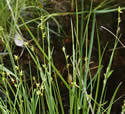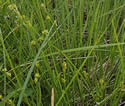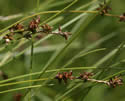Carex interior (Inland Sedge)
| Also known as: | |
|---|---|
| Genus: | Carex |
| Family: | Cyperaceae (Sedge) |
| Life cycle: | perennial |
| Origin: | native |
| Habitat: | part shade, shade, sun; wet; swamps, bogs, fens, shores, wet meadows, prairie swales, wet ditches |
| Fruiting season: | June - July |
| Plant height: | 8 to 36 inches |
| Wetland Indicator Status: | GP: OBL MW: OBL NCNE: OBL |
| MN county distribution (click map to enlarge): |  |
| National distribution (click map to enlarge): |  |
Pick an image for a larger view. See the glossary for icon descriptions.
Detailed Information
Spikes: 

![[photo of spike clusters]](/udata/r9ndp23q/pd3/carex-interior-061317-3-t.jpg) A cluster to 1½ inches long at the top of the stem, made up of 2 to 5 small spikes (usually 3, rarely 6), usually close together but not tightly crowded. All spikes are stalkless, the terminal spike with pistillate (female) flowers at the tip and a well-defined staminate (male) portion at the base (gynecandrous). Lateral spikes are up to 7 mm (~¼ inch) long, mostly pistillate with few (or no) staminate flowers at the base. The lowest spike has a scale-like bract at the base that may have a short, bristle tip, but bracts are mostly inconspicuous.
A cluster to 1½ inches long at the top of the stem, made up of 2 to 5 small spikes (usually 3, rarely 6), usually close together but not tightly crowded. All spikes are stalkless, the terminal spike with pistillate (female) flowers at the tip and a well-defined staminate (male) portion at the base (gynecandrous). Lateral spikes are up to 7 mm (~¼ inch) long, mostly pistillate with few (or no) staminate flowers at the base. The lowest spike has a scale-like bract at the base that may have a short, bristle tip, but bracts are mostly inconspicuous.
Leaves and stems: 

![[photo of sheath and ligule]](/udata/r9ndp23q/grass/carex-interior_0607_093834-t.jpg) Leaves are alternate with 3 to 5 leaves on the lower third of the stem, up to 12 inches long, .6 to 2.8 mm wide, flat or pleated, hairless, rough along the edges especially near the tip. Some leaves may initially rise above some flowering stems but most do not. Stem leaf sheaths tightly wrap the stem and are translucent whitish, concave at the tip. The ligule (membrane where the leaf joins the sheath) is more or less as long as wide and rounded or pointed at the tip. A few old, dead leaves may persist to the next season.
Leaves are alternate with 3 to 5 leaves on the lower third of the stem, up to 12 inches long, .6 to 2.8 mm wide, flat or pleated, hairless, rough along the edges especially near the tip. Some leaves may initially rise above some flowering stems but most do not. Stem leaf sheaths tightly wrap the stem and are translucent whitish, concave at the tip. The ligule (membrane where the leaf joins the sheath) is more or less as long as wide and rounded or pointed at the tip. A few old, dead leaves may persist to the next season.
![[photo of plant base]](/udata/r9ndp23q/grass/carex-interior_0613_191054-t.jpg) Bases are wrapped in a brown sheath that is not fibrous. Stems are erect to ascending, slender, 3-sided, rough textured on the upper stem, and may elongate up to about 3 feet at maturity. Plants are densely clump-forming from a mix of flowering and vegetative stems.
Bases are wrapped in a brown sheath that is not fibrous. Stems are erect to ascending, slender, 3-sided, rough textured on the upper stem, and may elongate up to about 3 feet at maturity. Plants are densely clump-forming from a mix of flowering and vegetative stems.
Fruit: 
![[close-up of mature spikes]](/udata/r9ndp23q/se/carex-interior-t.jpg) Fruit develops in late spring through early summer, the pistillate spikes forming clusters of seeds (achenes), each wrapped in a casing (perigynium), subtended by a scale. Pistillate spikes each contain 3 to 15 fruits that are mostly spreading to reflexed (downward pointing).
Fruit develops in late spring through early summer, the pistillate spikes forming clusters of seeds (achenes), each wrapped in a casing (perigynium), subtended by a scale. Pistillate spikes each contain 3 to 15 fruits that are mostly spreading to reflexed (downward pointing).
![[photo of perigynia, scale and achene]](/udata/r9ndp23q/grass/carex-interior-616-s2-t.jpg) Pistillate scales
are broadly egg-shaped, translucent white to brown-tinged with a green midrib, rounded to softly pointed at the tip, awnless, half to about 2/3 as long as the perigynia.
Perigynia
are 1.9 to 3(3.3) mm long, 1.1 to 1.8 mm wide, green turning somewhat shiny chestnut to dark brown at maturity, hairless, thickened and spongy at the base, flattened on the back side, 4 to 12-veined on the front, veinless or sometimes veined on the back, mostly egg-shaped in outline and widest near the base, abruptly tapering at the tip to a beak .4 to .9 mm long that is not more than half as long as the body and is minutely toothed along the edges.
Achenes
are 1.2 to 1.8 mm long, .9 to 1.5 mm wide, flattened lens-shaped, about as long as wide, broadest near the base, and mature to golden yellow.
Pistillate scales
are broadly egg-shaped, translucent white to brown-tinged with a green midrib, rounded to softly pointed at the tip, awnless, half to about 2/3 as long as the perigynia.
Perigynia
are 1.9 to 3(3.3) mm long, 1.1 to 1.8 mm wide, green turning somewhat shiny chestnut to dark brown at maturity, hairless, thickened and spongy at the base, flattened on the back side, 4 to 12-veined on the front, veinless or sometimes veined on the back, mostly egg-shaped in outline and widest near the base, abruptly tapering at the tip to a beak .4 to .9 mm long that is not more than half as long as the body and is minutely toothed along the edges.
Achenes
are 1.2 to 1.8 mm long, .9 to 1.5 mm wide, flattened lens-shaped, about as long as wide, broadest near the base, and mature to golden yellow.
Notes:
Carex interior is a common sedge of wet, sometimes calcareous soils, usually open spaces but tolerates some shade as well. Habitats include cedar and black ash swamps, marly shores, sphagnum bogs, prairie swales, sedge meadows, calcareous fens, clearings in wet woods, open peatlands, and the occasional road ditch.
Carex is a large genus, with over 600 species in North America and 150+ in Minnesota alone. They are grouped into sections, the species in each group having common traits. Carex interior is a member of the Stellulatae section; some of the section's common traits are: clump forming, basal sheaths not fibrous, leaves V-shaped in cross-section when young, usually 2 to 10 spikes per stem, terminal spike staminate or pistillate or with pistillate flowers at the tip (gynecandrous), pistillate scales blunt to pointed at the tip, perigynia widely spreading, hairless, veined at least on one side, spongy at the base, 2 short teeth on the beak, achenes lens-shaped. There are similarities with some members of the Phaestoglochin section, which have spikes with staminate flowers above the pistillate (androgynous).
Carex interior may be distinguished from other Carex species by: 2 to 5 (commonly 3) gynecandrous spikes at the tip of the stem, not usually crowded, 3 to 15 perigynia per spike, the terminal spike with a well-defined staminate portion and stalkless lateral spikes with few (or no) staminate flowers; perigynia 1.9 to 3 mm long, spongy at the base, the body oval to egg-shaped and widest at or near the base, usually veined on one side, sometimes both sides, usually with an abrupt taper to a short beak less than half as long as the body; achenes lens-shaped, about as long as wide.
Carex interior is most likely to be confused with Carex echinata, which has 3 to 8 spikes (commonly 4 to 6) with more perigynia (up to 30+), larger perigynia (most 3+ mm long) usually with more gradual taper to a longer beak, at least half as long as the body, where C. interior commonly has 3 spikes with up to 15 perigynia, perigynia are usually less than 3 mm long with a shorter, more abruptly tapered beak less than half as long as the body. However, C. echinata is a variable species, most distinct when perigynia are narrowly triangular with a long beak; when its perigynia are more egg-shaped to oval with an apparently shorter beak, the number of spikes per stem and number of perigynia per spike may help ID it, but the beak of C. interior is typically much stubbier by comparison. Also similar is Carex sterilis, which commonly has stems with only all-staminate or all-pistillate spikes, but mixed spikes are likely present as well. As with most Carex, several plants in a population should be checked for these traits.
Native Plant Nurseries, Restoration and Landscaping Services ↓
More photos
 Carex interior plant
Carex interior plant Carex interior plant
Carex interior plant Carex interior plant
Carex interior plant Carex interior at the edge of a pool in a forest clearing
Carex interior at the edge of a pool in a forest clearing Carex interior in a wet sedge meadow
Carex interior in a wet sedge meadow mature spikes are dark brown
mature spikes are dark brown
Photos by K. Chayka taken in Anoka, Brown and Lake of the Woods counties. Photos by Peter M. Dziuk taken in Anoka, Brown, Kandiyohi, Lake, Lake of the Woods, Pope and Redwood counties. Photos by Steve Eggers taken in Mille Lacs County.
Comments
Have you seen this plant in Minnesota, or have any other comments about it?






